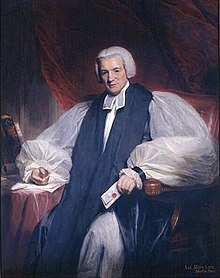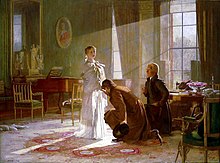William Howley: Difference between revisions
→Life as Archbishop of Canterbury: add img; move img |
|||
| Line 62: | Line 62: | ||
==Life as Archbishop of Canterbury== |
==Life as Archbishop of Canterbury== |
||
[[File:William Howley, Bishop of London (1766-1848) by Francis Leggatt Chantrey.jpg|thumb|right|[[Marble]] [[Bust (sculpture)|bust]] of Howley by [[Joseph Nollekens]], 1821. [[Yale Center for British Art]]]] |
|||
Howley was Archbishop during the repeal of the Test and Corporation Acts (1828), the [[Catholic Relief Act 1829|Emancipation of the Catholics]] (1829) and the passing of the [[Reform Act 1832|Great Reform Act]] (1832.) The bench of bishops was generally opposed to all three measures. As Archbishop, Howley was their spokesman and his heart-felt opposition to the Great Reform Act led to his carriage being attacked in the streets of Canterbury. |
Howley was Archbishop during the repeal of the Test and Corporation Acts (1828), the [[Catholic Relief Act 1829|Emancipation of the Catholics]] (1829) and the passing of the [[Reform Act 1832|Great Reform Act]] (1832.) The bench of bishops was generally opposed to all three measures. As Archbishop, Howley was their spokesman and his heart-felt opposition to the Great Reform Act led to his carriage being attacked in the streets of Canterbury. |
||
Like very many other bishops at that time, Howley was an "old-[[High Church]]man." These inherited a tradition of high views of the sacraments from the [[Caroline Divines]] and their successors. They held Catholic beliefs but were consistently anti-Roman. They were often despised by the more extreme [[Tractarian]]s and their beliefs were often obscured.<ref>e.g. in R.W. Church's classic account of the Oxford Movement.</ref> |
Like very many other bishops at that time, Howley was an "old-[[High Church]]man." These inherited a tradition of high views of the sacraments from the [[Caroline Divines]] and their successors. They held Catholic beliefs but were consistently anti-Roman. They were often despised by the more extreme [[Tractarian]]s and their beliefs were often obscured.<ref>e.g. in R.W. Church's classic account of the Oxford Movement.</ref> |
||
| ⚫ | |||
Archbishop Howley presided over the coronation of [[William IV of the United Kingdom|William IV]] and [[Adelaide of Saxe-Meiningen|Queen Adelaide]] in 1831. At 5 a.m. on 20 June 1837, accompanied by the [[Lord Chamberlain]], [[Francis Nathaniel Conyngham, 2nd Marquess Conyngham|the Marquis Conyngham]], the Archbishop went to [[Kensington Palace]] to inform [[Queen Victoria|Princess Victoria]] that she was now [[Queen of Great Britain and Ireland]]. |
Archbishop Howley presided over the coronation of [[William IV of the United Kingdom|William IV]] and [[Adelaide of Saxe-Meiningen|Queen Adelaide]] in 1831. At 5 a.m. on 20 June 1837, accompanied by the [[Lord Chamberlain]], [[Francis Nathaniel Conyngham, 2nd Marquess Conyngham|the Marquis Conyngham]], the Archbishop went to [[Kensington Palace]] to inform [[Queen Victoria|Princess Victoria]] that she was now [[Queen of Great Britain and Ireland]]. |
||
Architecture was of particular interest to him. During his career, he initiated the renovation and rebuilding of: his official house at Oxford, his town residence while Bishop of London (32 [[St. James's Square]]), [[Fulham Palace]] (also while he was Bishop of London), and finally, extensive renovations to Lambeth Palace. This last project was a virtual reconstruction of the Palace carried out by [[Edward Blore]], the work beginning after 1828 and done mainly in the [[Gothic Revival]] style. It took several years and cost upwards of £60,000. |
Architecture was of particular interest to him. During his career, he initiated the renovation and rebuilding of: his official house at Oxford, his town residence while Bishop of London (32 [[St. James's Square]]), [[Fulham Palace]] (also while he was Bishop of London), and finally, extensive renovations to Lambeth Palace. This last project was a virtual reconstruction of the Palace carried out by [[Edward Blore]], the work beginning after 1828 and done mainly in the [[Gothic Revival]] style. It took several years and cost upwards of £60,000. |
||
| ⚫ | |||
William Howley was married on 29 August 1805 to Mary Frances Belli, a daughter of John Belli, [[EICS]], (1740–1805) of Southampton who had been Private Secretary to [[Warren Hastings]]. The Howleys had two sons and three daughters; neither son reached adulthood. One of his daughters married [[Sir George Beaumont, 8th Baronet|Sir George Howland Willoughby Beaumont]], a nephew of [[Sir George Beaumont, 7th Baronet]]. William Howley died in 1848 and was interred at [[Addington, London|Addington]] after an elaborate funeral. |
William Howley was married on 29 August 1805 to Mary Frances Belli, a daughter of John Belli, [[EICS]], (1740–1805) of Southampton who had been Private Secretary to [[Warren Hastings]]. The Howleys had two sons and three daughters; neither son reached adulthood. One of his daughters married [[Sir George Beaumont, 8th Baronet|Sir George Howland Willoughby Beaumont]], a nephew of [[Sir George Beaumont, 7th Baronet]]. William Howley died in 1848 and was interred at [[Addington, London|Addington]] after an elaborate funeral. |
||
Revision as of 17:57, 22 March 2013
William Howley | |
|---|---|
| Archbishop of Canterbury | |
 | |
| Installed | 1828 |
| Term ended | 1848 |
| Predecessor | Charles Manners-Sutton |
| Successor | John Sumner |
| Personal details | |
| Born | 12 February 1766 |
| Died | 11 February 1848 Lambeth Palace |
| Buried | St Mary the Blessed Virgin Church, Addington, London |
William Howley (1766–1848) was a clergyman in the Church of England. He served as Archbishop of Canterbury from 1828 to 1848.
Early Life, education, and interests
Howley's grandfather was, probably, a Lawrence Hooley/Howley of Heaton Mersey: and his uncle, Joseph Hooley [sic] was vicar of Newtown Linford, Leics. Both father and [presumed] uncle went to Brasenose College, Oxford. Howley was born in 1766 at Ropley, Hampshire, where his father was vicar. He was educated at Winchester School and in 1783 went to New College, Oxford. After some time working in Somerset as a private tutor,[1] in 1809 he was appointed regius Professor of Divinity at Oxford University (as well as becoming a Fellow of Winchester and a Canon of Christ Church, Oxford.)
He was an active English Freemason, having joined the 'Royal York Lodge' in Bristol on 21 December 1791,[2] aged 25, and served the lodge regularly until his elevation to the episcopate took him to London.[3][4]
In October 1813, at Lambeth Palace, he was consecrated Bishop of London, a post he was to occupy until 1828, when he became Archbishop of Canterbury.
Life as Archbishop of Canterbury

Howley was Archbishop during the repeal of the Test and Corporation Acts (1828), the Emancipation of the Catholics (1829) and the passing of the Great Reform Act (1832.) The bench of bishops was generally opposed to all three measures. As Archbishop, Howley was their spokesman and his heart-felt opposition to the Great Reform Act led to his carriage being attacked in the streets of Canterbury.
Like very many other bishops at that time, Howley was an "old-High Churchman." These inherited a tradition of high views of the sacraments from the Caroline Divines and their successors. They held Catholic beliefs but were consistently anti-Roman. They were often despised by the more extreme Tractarians and their beliefs were often obscured.[5]
Archbishop Howley presided over the coronation of William IV and Queen Adelaide in 1831. At 5 a.m. on 20 June 1837, accompanied by the Lord Chamberlain, the Marquis Conyngham, the Archbishop went to Kensington Palace to inform Princess Victoria that she was now Queen of Great Britain and Ireland.
Architecture was of particular interest to him. During his career, he initiated the renovation and rebuilding of: his official house at Oxford, his town residence while Bishop of London (32 St. James's Square), Fulham Palace (also while he was Bishop of London), and finally, extensive renovations to Lambeth Palace. This last project was a virtual reconstruction of the Palace carried out by Edward Blore, the work beginning after 1828 and done mainly in the Gothic Revival style. It took several years and cost upwards of £60,000.

William Howley was married on 29 August 1805 to Mary Frances Belli, a daughter of John Belli, EICS, (1740–1805) of Southampton who had been Private Secretary to Warren Hastings. The Howleys had two sons and three daughters; neither son reached adulthood. One of his daughters married Sir George Howland Willoughby Beaumont, a nephew of Sir George Beaumont, 7th Baronet. William Howley died in 1848 and was interred at Addington after an elaborate funeral.
References
- ^ See MQ magazine, issue 20 (January 2007), page 31 - biographical research by Barry Leat.
- ^ Freemasonry in Bristol, Powell & Littlejohn, privately published.
- ^ See also the Freemasons' Review, June 1844 edition - Howley's masonry was a well known contemporary fact.
- ^ See also the Freemasons' Quarterly Review, first quarter, 1835 - a survey of the Archbishop's masonic career.
- ^ e.g. in R.W. Church's classic account of the Oxford Movement.
Further reading
J.R. Garrard, William Howley (1766–1848), Bishop of London 1813-28, Archbishop of Canterbury 1828-48, Univ. of Oxford unpubl. D.Phil. thesis, 1992.
